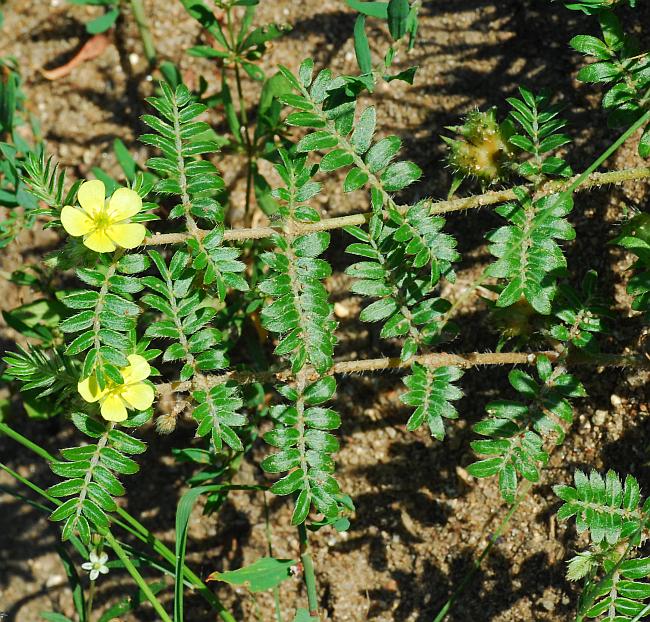Tribulus terrestris L.
Puncture Vine

Introduced
CC = *
CW = 5
MOC = 36
© SRTurner
Tribulus terrestris L.Puncture Vine | |
 |
Introduced CC = * CW = 5 MOC = 36 |
© SRTurner |
|
Family - Zygophyllaceae Habit - Annual forb. Stem - To 1 m, prostrate, pubescent with minute curled hairs and longer stiff hairs.
Leaves - Opposite, even-pinnately compound, with one leaf at a node usually distinctly larger than the other. Leaves to 5 cm long, elliptic in outline, with 6-8 pairs of leaflets, these densely pubescent on undersurface and margin, the upper surface pubescent, sometimes only along midvein.
Calyx - Sepals 5, free, 2-4 mm long, densely pubescent.
Flowers - Corollas of 5 free petals, yellow, sometimes fading to white. Stamens 10, in 2 series opposite the sepals and petals. Ovary 1 per flower, superior, of 5 fused carpels, with 5 or 10 locules. Style and stigma 1 per flower. Ovules 1 or few per locule.
Fruit - Schizocarps, 7-12 mm in diameter, depressed globose, strongly 5-lobed, each mericarp with two stout, sharp spines.
Flowering - June - September. Habitat - Open, disturbed areas. Prefers sandy soils. Origin - Native to Mediterranean region. Lookalikes - None. Other info. - A caltrop is an device which, when tossed upon the ground, will always orient a sharp spine upward. They have been used as antipersonnel devices and to puncture tires of fleeing vehicles. Although the fruits of this plant may not operate precisely in that manner, they do have a reputation for puncturing bicycle tires. Ironically, many of the above photos were taken at trailhead locations for the Katy biking trail! This may suggest that the species is spread by mowing equipment. The plant is abundant in western regions of the continental U.S., scattered in Missouri, and rare to absent to the east. It is considered a noxious weed in many western states. Not only do the spines puncture tires and injure grazing animals, but the plants are also poisonous to livestock. The foliage contains saponins and small amounts of alkaloids, and can cause liver damage. Photographs taken along the Katy Trail near Treloar, Warren County, MO, 6-26-2012, at Rose Pond Conservation Area, Clark County, MO, 7-9-2017, along the Katy Trail near Marthasville, Warren County, MO, 9-5-2019, and along the along the Katy Trail near McKittrick, Montgomery County, MO, 9-17-2020 (SRTurner). |